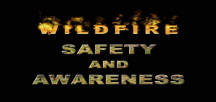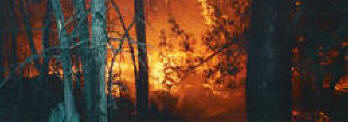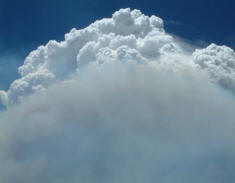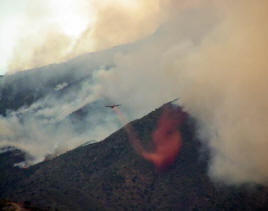

The High Country Xeriscape Council of Arizona is a non-profit 501 C-3 corporation dedicated to educating our communities about water-wise gardening. For additional information write:
HCXCA
4397 E AZ Highway 260
Payson, AZ 85541

5 Ways to Protect Your Home From Fire
When temperatures reach upwards of 2,000°, as they did at the climax of the Oakland/ Berkeley Hills fire (Tunnel fire) of 1991, everything burns and there's nothing you can do to stop the oncoming conflagration. But if you take steps to make your house resistant to lesser fires, it may survive.
Typically, homes burn because the roof catches fire — each broad expanse is an open invitation to windblown embers, whether from nearby homes or from burning vegetation in adjacent landscaping or wildland. So the best precaution you can take in a fire-prone area is to make your roof fire-resistant.
Roof materials are rated from A to C for resistance to fire, with A being the most resistant. Install a class A roof if you can. (See chart.) "The cost difference is so little that a B- or C-class roof doesn't make sense. Class A roofs make for safe communities," says Gerson Bers of Gale Associates in Mountain View, California, a roofing consulting firm.
After seeing to your roof, you can take many other steps to protect your home. These measures are based on the following principles:
Use fire-resistant materials wherever possible.
Deny fire all entry points. For instance, cover eave overhangs and close off deck underpinnings.
Don't let tinder – dead leaves, debris – accumulate on your roof, in gutters and vents, or under decks.
Windows and skylights are particular points of vulnerability, as their materials will break or burn at relatively low heat. Consider reducing the size and number of windows facing wooded areas; consider eliminating skylights. At a minimum, use thermal-pane glass. Operable metal shutters and fire-resistant curtains can help.
Avoid providing fire with extra fuel and pathways to your house via wooden trellises, fences, or sheds.
Choosing the Right Roof
Life spans and costs vary dramatically by the job and location. Figures here are based on tearing a 3,200-square-foot roof off an uncomplicated 1,900-square-foot house, adding bracing where needed, and using solid 1/2-inch plywood decking and #30 roofing felt.
Check with local building officials about codes and necessary permits. Proper installation is critical to performance, appearance, and life span. – Barbara Boughton with Gary Kruse - see sunset website Choosing the right roof
Create a Landscape that Fights Fire
The concept of defensible space is based on some simple principles.
Keep the area around the house free of potential fuel, such as overhanging tree branches (prune them to 15 to 20 feet away from the house) or woodpiles (stack them 30 feet away and uphill from house, sheds, or fences).
Do not landscape with flammable plants — those whose leaves are high in oils or resins (such as junipers), or low in moisture (see list below); keep all plantings well watered and free of dead material.
Thin dense stands of trees or shrubs to prevent them from fueling an intense buildup of fire and to eliminate fire "ladders" — plantings at graduated heights that allow fire to climb from the ground through tall shrubs and low tree branches up to treetops and roofs.
Keep property clear of debris.
Create fuel breaks where possible: Install a pool or other water feature, build fences with nonflammable materials, and cover open ground with gravel, rock, brick, paving, or other nonflammable substances.
Create Defensible Zones
Wildfire spreads most readily in the wildland-urban interface, where homes are surrounded by native vegetation and woodland. In such locations, homeowner precautions are not only recommended, they may be required. What's right for your home will depend on the size and slope of your property (if you have a steep slope, take maximum precautions), your neighborhood, the type of climate and surrounding vegetation, and local regulations. Local fire departments are the best source of information for your area. The following zone guidelines are adapted from Colorado State Forest Service recommendations and are designed for homes in interface areas. Adapt these guidelines to your property.
ZONE 1. This zone extends 30 feet around the structure (up to 100 feet in high-hazard areas), measured outward from house eaves and attached structures like decks. Plant nothing within 3 to 5 feet of the house. Beyond that, maintain an irrigated greenbelt with ground covers, lawn, or mowed native vegetation. If you leave a tree in this zone, consider it part of the structure and extend the defensible space accordingly.
ZONE 2. This area, which extends 75 to 100 feet outward from the structure (farthest on sloped properties and in dry-summer areas), is a fuel reduction zone. Clear away all dead vegetation, remove tree branches below 10 feet, and properly space plants (there should be 10 feet between the crowns of trees, for instance). Irrigate if possible.
ZONE 3. This is any area of native vegetation extending beyond the edge of your groomed space. If possible, remove diseased or dying trees and keep trails clear. – Lance Walheim
Make sure there are no tree limbs close to your chimney or dead branches hanging over the roof.
Keep tree branches at least 15 feet away from your house.
To avoid accidentally starting a fire with a chain saw, prune and trim well before fire season.
Keep dry fronds pruned from palms.
Make sure your address number is clearly visible from the road, so firefighters can find your home easily in an emergency. "To be visible, the numbers on your house should be at least 6 inches tall," says Captain Vicky Evans-Robinson, public information officer with the Oakland Fire Department.
Select Plants Intelligently
Selecting plants in fire country isn't simple. Plants should be chosen not only according to their fire resistance — low growth habit, low fuel volume, high moisture content — but also for such factors as their drought tolerance, deep-rooting habit, attractiveness, and compatibility with other plants in your garden and the native environment. Generally, you want to avoid highly flammable ones (see list below). And if you garden on a slope, you must consider the slope's stability. Broad-leafed and succulent plants tend to burn less readily than plants with needlelike foliage or fine leaves. A trailing or compact form of a plant, such as ceanothus, has a lower fuel load than upright forms. And plants like agapanthus and daylilies have little fuel supply.
But don't think one plant will solve all your problems. Although ice plant has a high moisture content and doesn't burn as readily as some plants, setting out masses of it is not a cure-all. The bright flowers of some kinds (Drosanthemum, Lampranthus) can be aesthetically incompatible with native chaparral. Carpobrotus won't prevent (and can even cause) slippage on a steep slope during heavy rains, and some kinds build up woody growth, which must be cleared out every five years or so.
Plants with low fuel volume, such as dusty miller, lavender, rockrose, santolina, and wallflower, are seemingly good choices. But because they're short-lived and must be replaced periodically, they may not be suitable for mass plantings.
Although many native species (oaks and manzanitas) burn readily, they're often good choices away from a house because of their drought resistance and ability to resprout after a fire. Choose low-growing ones and space them widely apart.
If you're unsure which plants will fit all these requirements, consult with a landscape architect, horticulturist, wildland specialist, or forester with knowledge of and experience in fire saftey in your area.
Plants to Avoid
These plants are among those known for the amount of dead fuel that accumulates in them, and the high oil, high resin, or low moisture content of their leaves and branches.
If you already have one or more of these, don't rip all of them out if they're essential to your landscape's look or soil stability. But if you're planting a new landscape, most shouldn't be used. Native plants (toyon and manzanita) can be planted sparingly if spaced widely. The bottom line: all plants are flammable if not pruned periodically, and the risk attached to any one kind of plant can be greatly diminished with maintenance.
Trees
Acacia
Arborvitae
California bay
Cedar (Chamaecyparis species, except dwarf kinds)
Cypress
Douglas fir (Pseudotsuga menziesii)
Eucalyptus
Juniper
Palm
Pine
Spruce
Yew
Shrubs, Groundcovers, Grasses
California buckwheat (Eriogonum fasciculatum)
California sagebrush
Chamise or greasewood (Adenostoma fasciculatum)
Deergrass (Muhlenbergia rigens)
Dry annual grasses
Fountain grass (Pennisetum species)
Juniper
Laurel sumac
Manzanita
Pampas grass
Rosemary
Scotch broom
Scrub oak
Spanish broom
Sugar bush
Home Owner's To-Do List
Annually
Clean up leaves and other plant litter.
Cut grasses to about 4 inches when they turn brown.
Remove brush that grew with the winter rains.
Clean all vegetation from the roof. Clean gutters several times during the year.
Keep plants near the house irrigated (water supply permitting).
Work with neighbors to clear common areas and prune heavy vegetation between houses.
Every Few Years 
In early spring, prune or mow down low-growing ground covers, such as ceanothus and Coprosma kirkii.
Periodically cut back native chaparral plants severely.
Budget for pruning and maintenance of trees you keep.
Thin crowns of clustered trees (keep trees 10 feet apart).
Trim limbs of tall trees up off the ground 20 feet or more.
Cut branches back 15 to 20 feet from the house.
Prune out all dead branches; remove all dead plants.
Along the driveway, clear out overhanging tree branches and prune back bushy shrubs for fire truck access (remember, trucks are tall and wide).
ref: Sunset Magazine - Sunset Magazine Web Site
copyright 2003© HCXCA

